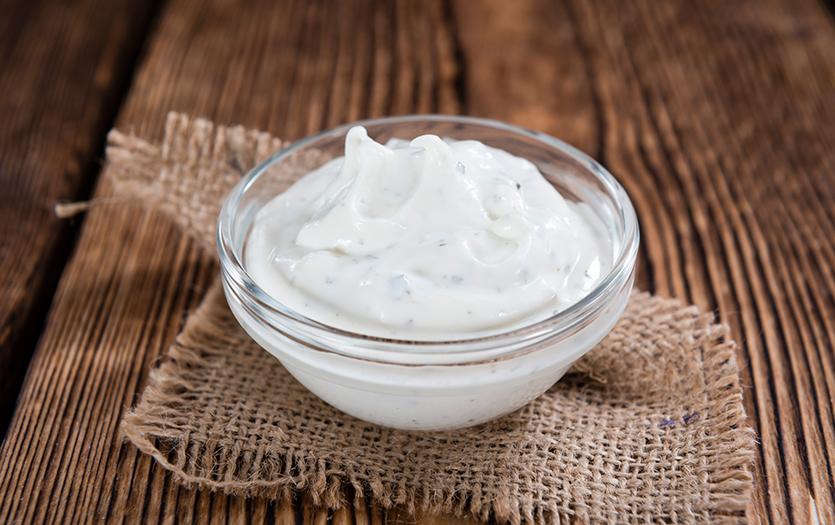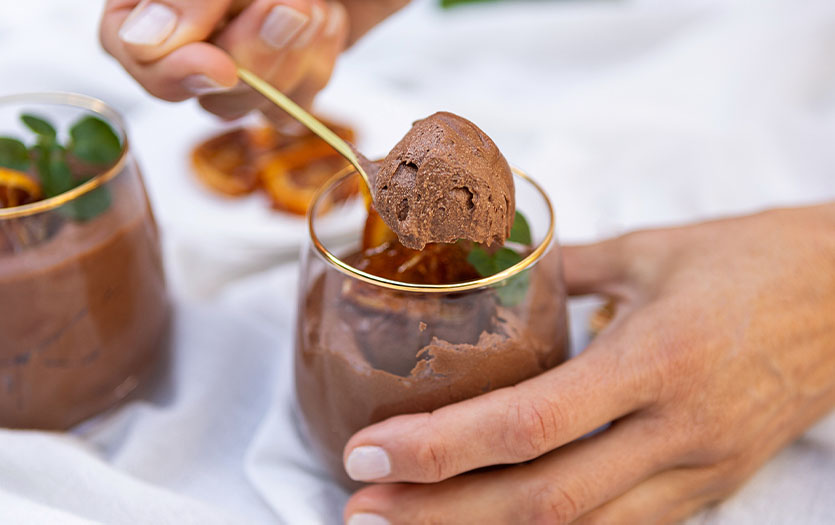
This post was written Lydia Conner, RDN, LD, community outreach dietitian, Center for Healthy Living.
Store-bought dressings and sauces may be convenient, but they also come with a lot of added sugar, high amounts of sodium and saturated fats. However, they add flavor and a satisfying element to many foods. So, how do you choose a dressing that is both satisfying and healthy? Let’s take a closer look at the satisfaction factor of food as well as how you can make your own dressings and sauces at home that are fun to create and nourishing in many ways!
The satisfaction factor
Have you ever heard of the satisfaction factor? It’s a principle that tells us we’re allowed to enjoy and receive satisfaction from the foods we eat, and it’s an important part of intuitive eating, which is a non-diet, weight-neutral approach to health. The satisfaction factor tells us that if we don’t eat foods we enjoy and that are satisfying, we will likely continue to look for something else to satisfy us, even when we are no longer physically hungry. This can lead to overeating later or obsessive thoughts about food.
Instead, you can listen to your senses to discover foods that sound satisfying to you, including considering the tastes, textures, aromas, temperatures and appearances that would help you enjoy your meal. By being aware of these factors, you can make choices based on what will leave you feeling satisfied at the end of a meal and less likely to seek out something else to eat.
For example, consider the appearance of a meal. If the thought of a poached, pale chicken breast with steamed cauliflower and mashed potatoes sounds unappealing, think about how you can transform it. Maybe you roast the chicken to a golden brown, replace the cauliflower with green asparagus spears and the potatoes with yams and cinnamon. Making a few changes didn’t make the meal less healthy — but it did change your enthusiasm for eating it and therefore will leave you feeling more satisfied.
Analyzing store-bought dressings
When thinking about dressings and sauces, it’s important to look at both the nutrition of what you’re eating as well as what will satisfy you the most. The Nutrition Facts label can tell you a lot about the nutritional value of food. Pre-made and pre-packaged foods, such as store-bought dressings, can be high in saturated fats, sugar and sodium because they serve to add flavor and/or preserve the food. Analyzing the Nutrition Facts label can help you understand how much of these ingredients are in your selections. Unfortunately, eating too many of these ingredients can put you at risk for health concerns like heart disease, hypertension and type II diabetes.
While all of this information is important, the Nutrition Facts label doesn’t give you any individualized information about what you will enjoy eating. And at the end of the day, choosing the dressing you like better may leave you feeling more satisfied. So, what’s the right choice? Let’s look at how homemade dressings may help you do both.
The benefits of homemade dressings
Making your own dressings at home has a number of benefits, both with the health/nutrition and the satisfaction factor of your foods, including:
- You can make enough dressing or sauce for a given recipe, so you don’t have to add any additives to prolong the shelf life.
- You can keep an eye out for how much sugar, salt and what kind of fat/oils you use (and choose ones that are heart-healthy!)
- You can add fresh herbs and spices to make your dressings and sauces more flavorful and nutritious.
- Awareness of the ingredients can prime you for enjoying the recipe as you smell the aromas and experience the process of preparing.
- You can experiment to determine what makes foods more satisfying to you.
If you’re ready to give homemade dressings a try, here are a few healthy and delicious recipes to get you started. Enjoy!
Recipes to try
Greek yogurt ranch
This dressing is delicious when served with carrots, celery or other vegetables. The Greek yogurt provides protein, reduces saturated fat and is more satisfying and better for your heart. Herbs and spices are great for flavor and antioxidants, lemon juice adds a tangy flavor and vitamin C, and honey has antibacterial benefits where regular white sugar does not.
1/2 cup nonfat plain Greek yogurt
1 teaspoon garlic powder
1/4 teaspoon onion powder
1 ½ teaspoon fresh lemon juice (can substitute apple cider vinegar)
1/2 teaspoon dried dill or fresh chopped chives
1/4 teaspoon salt, plus more to taste
2 tablespoons water to thin dressing
1/4 teaspoon honey (optional)
- Add all ingredients to a bowl or mason jar and mix until well combined. If using a mason jar, you can simply put the lid on and shake the jar until mixed.
Recipe modified from one featured on Ambitious Kitchen.
Cilantro lime vinaigrette
This dressing is great on salads, pasta salads, etc. It is a simple recipe, but the fresh herbs can provide phytochemicals to protect our body’s cells from damage from environmental free radicals.
¼ cup lime juice
2 tablespoons chopped fresh cilantro
2 teaspoons honey
1 clove minced garlic
¾ cup extra virgin olive oil
- Add all ingredients to a jar, close tightly and shake well to combine.
Peanut sauce
This sauce can be served with spring rolls, pad Thai, etc. The thicker sauce uses creamy natural peanut butter which provides a heart-healthy creamy consistency that boosts the satiety of the dish. The vinegar adds a tang, the soy sauce provides some salty umami flavor and the sweetener balances the flavors out.
⅓ cup creamy natural peanut butter
2 tablespoons rice vinegar
2 tablespoons reduced-sodium soy sauce
2 tablespoons honey or maple syrup
1 tablespoon toasted sesame oil
2 cloves garlic, pressed or minced
2 to 3 tablespoons water, as needed
- In a small bowl, whisk together the peanut butter, rice vinegar, soy sauce, honey, sesame oil and garlic. Whisk in 2 to 3 tablespoons water, as needed, to make a super creamy but dip-able sauce.
Recipe modified from one featured on Cookie and Kate.



